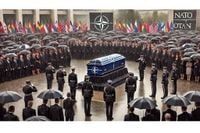An observer of the American portal 19FortyFive, relying on the opinion of experts, has labeled the C1 Ariete as the worst tank of the North Atlantic Alliance, drawing attention to its significant shortcomings. Developed by the consortium Consorzio Iveco Oto Melara (CIO), this main battle tank has been in service with the Italian army since the mid-1990s, but it faces profound criticisms that raise questions about its combat readiness and effectiveness on modern battlefields.
One of the primary concerns regarding the C1 Ariete is its armor, which is considered thinner when compared to its NATO counterparts, such as the Leopard 2 and Challenger 2. This makes the C1 Ariete particularly vulnerable on the battlefield, as armor thickness is a crucial factor in determining a tank's survivability against enemy fire. Defense analysts argue that in today’s combat scenarios, especially with advancements in anti-tank weaponry, the thin armor of the C1 Ariete could be a fatal flaw.
Adding to the woes of the C1 Ariete is its lack of modernization. Unlike many modern tanks that have been continually upgraded to keep pace with evolving combat requirements and technological advancements, the C1 Ariete has not seen significant improvements in its capabilities. The report emphasizes that without upgrades, it has fallen markedly behind other tanks in terms of both technological features and combat effectiveness.
Currently, the Italian army operates just 200 units of the C1 Ariete, a number that is relatively small compared to the armored forces of other NATO countries. Under these conditions, experts predict that the influence of the C1 Ariete on the battlefield would be minimal, especially in the event of a large-scale war. This raises critical questions about the Italian military's strategy and preparedness in a potential conflict environment.
Furthermore, many military strategists are looking at the implications of these criticisms for the future of the C1 Ariete and whether Italy will take steps to improve or replace its aging fleet. The ongoing conversation around the tank reflects a broader discussion within NATO regarding the need for modernization in response to sophisticated threats that challenge traditional combat systems.
In light of these evaluations, the integrity of the C1 Ariete as a combat vehicle is under scrutiny. As NATO forces face a rapidly changing battlefield, the pressure for countries like Italy to ensure their armored vehicles meet modern standards continues to grow. The outcome of such assessments could lead to significant military reforms, eventually shaping the future composition of European defense forces.
The analysis from 19FortyFive ultimately points out that while the C1 Ariete once served as an important asset for the Italian army, its position as the worst tank in NATO may necessitate a critical reassessment of Italy’s defense capabilities and spending. In a post-Cold War landscape characterized by unpredictable threats and the need for robust military responses, investment and modernization of the armed forces become paramount.
The evaluation of the C1 Ariete opens not only discussions about this specific tank but also broader considerations about military preparedness and the criteria used to evaluate the effectiveness of armored units within the alliance. With attention now turned toward upgrading and modernizing obsolete systems, the question remains: how quickly will the Italian army respond to these glaring deficiencies?






